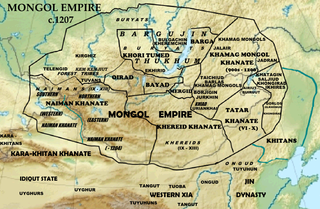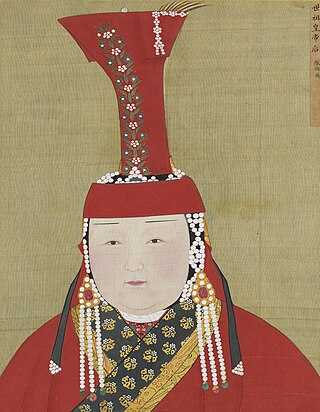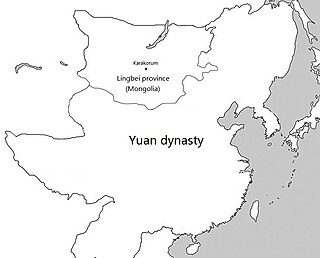
Throughout Chinese history, "Emperor" was the superlative title held by the monarchs who ruled various imperial dynasties or Chinese empires. In traditional Chinese political theory, the emperor was the "Son of Heaven", an autocrat with the divine mandate right to rule all under Heaven. Emperors were worshiped posthumously under an imperial cult. The lineage of emperors descended from a paternal family line constituted a dynasty, and succession in most cases theoretically followed agnatic primogeniture.

Hong Taiji, also rendered as Huang Taiji and sometimes referred to as Abahai in Western literature, also known by his temple name as the Emperor Taizong of Qing, was the second khan of the Later Jin dynasty and the founding emperor of the Qing dynasty. He was responsible for consolidating the empire that his father Nurhaci had founded and laid the groundwork for the conquest of the Ming dynasty, although he died before this was accomplished. He was also responsible for changing the name of the Jurchens to "Manchu" in 1635, and changing the name of his dynasty from "Great Jin" to "Great Qing" in 1636.

A Borjigin is a member of the Mongol sub-clan that started with Bodonchar Munkhag of the Kiyat clan. Yesugei's descendants were thus said to be Kiyat-Borjigin. The senior Borjigids provided ruling princes for Mongolia and Inner Mongolia until the 20th century. The clan formed the ruling class among the Mongols and some other peoples of Central Asia and Eastern Europe. Today, the Borjigid are found in most of Mongolia, Inner Mongolia and Xinjiang, and genetic research has shown that descent from Genghis Khan and Timur is common throughout Central Asia and other regions.
Örüg Temür Khan, possibly Guilichi, (?–1408) was a khagan of the Northern Yuan dynasty, reigning from 1402 to 1408. Örüg Temür in historical materials compiled by the Timurid dynasty have been a descendant of Ögedei. Örüg Temür might also have been descended from either Ariq Böke or Genghis Khan's younger brothers, either Hasar or Temüge.
Bolad, was an ethnic Mongol minister of the Yuan dynasty of China, and later served in the Ilkhanate as the representative of the Great Khan of the Mongol Empire and cultural adviser to the Ilkhans. He also provided valuable information to Rashid-al-Din Hamadani to write about the Mongols. Mongolists consider him a cultural bridge between East and West. He was ennobled by Emperor Renzong of Yuan as Duke of Ze (澤國公) in 1311 and Prince of Yongfeng (永豐郡王) in 1313, posthumously.

The Yuan dynasty, officially the Great Yuan, was a Mongol-led imperial dynasty of China and a successor state to the Mongol Empire after its division. It was established by Kublai, the fifth khagan-emperor of the Mongol Empire from the Borjigin clan, and lasted from 1271 to 1368. In Chinese history, the Yuan dynasty followed the Song dynasty and preceded the Ming dynasty.

The Northern Yuan was a dynastic regime ruled by the Mongol Borjigin clan based in the Mongolian Plateau. It existed as a rump state after the collapse of the Yuan dynasty in 1368 and lasted until its conquest by the Jurchen-led Later Jin dynasty in 1635. The Northern Yuan dynasty began with the retreat of the Yuan imperial court led by Toghon Temür to the Mongolian steppe. This period featured factional struggles and the often only nominal role of the Great Khan.

Kublai Khan, also known by his temple name as the Emperor Shizu of Yuan and his regnal name Setsen Khan, was the founder and first emperor of the Mongol-led Yuan dynasty of China. He proclaimed the dynastic name "Great Yuan" in 1271, and ruled Yuan China until his death in 1294.
Various nomadic empires, including the Xiongnu, the Xianbei state, the Rouran Khaganate (330–555), the First (552–603) and Second Turkic Khaganates (682–744) and others, ruled the area of present-day Mongolia. The Khitan people, who used a para-Mongolic language, founded an empire known as the Liao dynasty (916–1125), and ruled Mongolia and portions of North China, northern Korea, and the present-day Russian Far East.
The Yuan dynasty (1271–1368) was a dynasty of China ruled by the Mongol Borjigin clan. Founded by Kublai Khan, it is considered one of the successors to the Mongol Empire.

Chabi was a Khongirad empress consort of the Mongol-led Yuan dynasty of China, married to Kublai Khan.

The Legend of Kublai Khan, also known as Legend of Yuan Empire Founder, is a Chinese television series based on the life of Kublai Khan and the events leading to the establishment of the Mongol-led Yuan dynasty in China. The series started shooting in 2011. It premiered at the 2013 Shanghai Television Festival from 11 to 13 June 2013, and was first aired on HBS from 21 to 30 July 2013. The series was directed by Tsui Siu-ming and starred Hu Jun and Charmaine Sheh as Kublai Khan and Chabi, along with Cai Wenyan, Wu Yue, Tang Guoqiang, Gao Fa, Steven Ma and Ray Lui in supporting roles.
The division of the Mongol Empire began after Möngke Khan died in 1259 in the siege of Diaoyu Castle with no declared successor, precipitating infighting between members of the Tolui family line for the title of khagan that escalated into the Toluid Civil War. This civil war, along with the Berke–Hulagu war and the subsequent Kaidu–Kublai war, greatly weakened the authority of the great khan over the entirety of the Mongol Empire, and the empire fractured into four khanates: the Golden Horde in Eastern Europe, the Chagatai Khanate in Central Asia, the Ilkhanate in Iran, and the Yuan dynasty in China based in modern-day Beijing – although the Yuan emperors held the nominal title of khagan of the empire.

Manchuria under Yuan rule refers to the Yuan dynasty's rule over Manchuria, corresponding to modern Manchuria and Outer Manchuria, from 1271 to 1368. Mongol rule over Manchuria was established after the Mongol Empire's conquest of the Jin dynasty and the Eastern Xia dynasty in the early 13th century. It became a part of the Yuan dynasty of China led by Kublai Khan in 1271. During the Yuan, it was administered as Liaoyang province. Even after the overthrow of the Yuan dynasty by the Ming dynasty in 1368, Manchuria was still controlled by the Northern Yuan dynasty for almost 20 years, until it was conquered by the Ming during its campaign against Naghachu and put under Ming rule.

The Yuan dynasty ruled over the Mongolian Plateau, including both Inner and Outer Mongolia as well as part of southern Siberia, between 1271 and 1368. The Mongolian Plateau is where the ruling Mongol Borjigin clan of the Yuan dynasty came from, thus it enjoyed a somewhat special status during the Yuan dynasty, although the capital of the dynasty had been moved from Karakorum to Khanbaliq since the beginning of Kublai Khan's reign, and Mongolia had been converted into a regular province, known as the Lingbei Province, by the early 14th century.

The Later Jin, officially known as Jin or the Great Jin, was a Jurchen-led royal dynasty of China in Manchuria and the precursor to the Qing dynasty. Established in 1616 by the Jianzhou Jurchen chieftain Nurhaci upon his reunification of the Jurchen tribes, its name was derived from the earlier Jin dynasty founded by the Wanyan clan which had ruled northern China in the 12th and 13th centuries.

The debate on the "Chineseness" of the Yuan and Qing dynasties is concerned with whether the Mongol-led Yuan dynasty (1271-1368) and the Manchu-led Qing dynasty (1644-1912) can be considered "Chinese dynasties", and whether they were representative of "China" during their respective historical periods. The debate, although historiographical in nature, has political implications. Mainstream academia and successive governments of China, including the imperial governments of the Yuan and Qing dynasties, have maintained the view that they were "Chinese" and representative of "China". The debate stemmed from differing opinions on whether regimes founded by ethnic minorities could be representative of "China", where the Han Chinese was and remains the main people. The Mongols and Manchus have been recognized by the Chinese governments since 1912.







































































